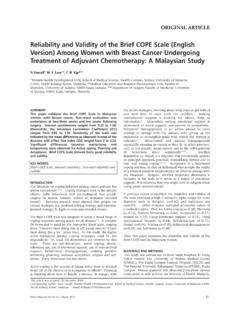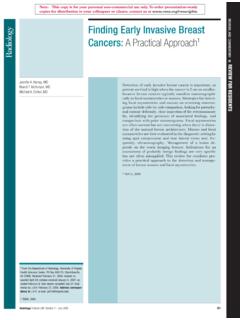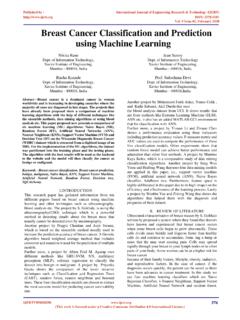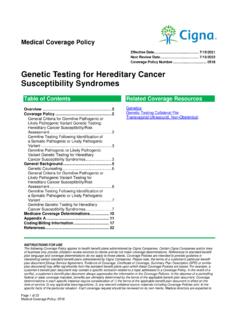Transcription of CANCER DRUG PHARMACOLOGY TABLE
1 BC CANCER Pharmacy Education Program CANCER drug PHARMACOLOGY TABLE 1/10 Author: Rhonda Kalyn, BC CANCER Reviewer: Mario de Lemos, BC CANCER Published: 2018-Feb-06 Updates: BC CANCER CON Pharmacy Educators Updated: 2022-July 13 CANCER drug PHARMACOLOGY TABLE Cytotoxic Chemotherapy Drugs are classified according to the BC CANCER drug Manual Monographs, unless otherwise specified (see asterisks). Subclassifications are in brackets where applicable. Alkylating Agents have reactive groups (usually alkyl) that attach to DNA or RNA, leading to interruption in synthesis of DNA, RNA, or proteins. bendamustine (nitrogen mustard) busulfan (alkyl sulfonate) carboplatin (platinum) carmustine (nitrosurea) chlorambucil (nitrogen mustard) cisplatin (platinum) cyclophosphamide (nitrogen mustard) dacarbazine (triazine) estramustine (nitrogen mustard with 17-beta-estradiol) hydroxyurea ifosfamide (nitrogen mustard) lomustine (nitrosurea) mechlorethamine (nitrogen mustard) melphalan (nitrogen mustard) oxaliplatin (platinum) procarbazine (triazine) streptozocin (nitrosurea) temozolomide (triazine) thiotepa (aziridine) treosulfan Antimetabolites are structural analogues of naturally occurring molecules required for DNA and RNA synthesis.
2 When substituted for the natural body substances, they disrupt DNA and RNA synthesis. azacitidine (pyrimidine analogue) capecitabine (pyrimidine analogue) cladribine (adenosine analogue) cytarabine (pyrimidine analogue) fludarabine (purine analogue) fluorouracil (pyrimidine analogue) gemcitabine (pyrimidine analogue) mercaptopurine (purine analogue) methotrexate (folate analogue) pralatrexate (folate analogue) pemetrexed (folate analogue) pentostatin (purine analogue) raltitrexed (folate analogue) thioguanine (purine analogue) trifluridine-tipiracil (pyrimidine analogue/thymidine phosphorylase inhibitor) BC CANCER Pharmacy Education Program CANCER drug PHARMACOLOGY TABLE 2/10 Author: Rhonda Kalyn, BC CANCER Reviewer: Mario de Lemos, BC CANCER Published: 2018-Feb-06 Updates.
3 BC CANCER CON Pharmacy Educators Updated: 2022-July 13 Antimicrotubule Agents (Mitotic Inhibitors) inhibit cell mitosis by interfering with microtubule formation or function. cabazitaxel (taxane) docetaxel (taxane) eribulin ixabepilone paclitaxel (regular and nanoparticle, albumin-bound) (taxane) vinblastine (vinca alkaloid) vincristine (vinca alkaloid) vinorelbine (vinca alkaloid) Miscellaneous Antineoplastics - Refer to BC CANCER monographs for PHARMACOLOGY . arsenic trioxide asparaginase bleomycin belinostat dactinomycin decitabine - cedazuridine iniparib lurbinectedin mitomycin mitotane pegaspargase porfimer romidepsin vorinostat Topoisomerase Inhibitors (I and II) cause DNA strand breaks by disrupting the function of topoisomerase enzymes, which are responsible for regulating the 3-D structure of DNA.
4 Topoisomerase I irinotecan topotecan Topoisomerase II amsacrine anthracyclines - daunorubicin - doxorubicin (regular and pegylated liposomal) - epirubicin - idarubicin etoposide mitoxantrone teniposide Hormonal Therapies Antiestrogens oppose the effects of estrogen. tamoxifen partial estrogen antagonist (antagonist on breast tissue, agonist on endometrium, bone and lipids) fulvestrant full estrogen antagonist (no agonist activity) Antiandrogens opposes the effects of androgens. apalutamide Aromatase Inhibitors (AIs) prevent the final step in the conversion of androgens to estrogens in peripheral tissues. anastrozole exemestane letrozole Luteinizing Hormone Releasing Hormone (LHRH) Agonists (also known as gonadotropin releasing hormone analogues) initially stimulate the release of luteinizing hormone, which leads to an increase in sex hormones BC CANCER Pharmacy Education Program CANCER drug PHARMACOLOGY TABLE 3/10 Author: Rhonda Kalyn, BC CANCER Reviewer: Mario de Lemos, BC CANCER Published: 2018-Feb-06 Updates: BC CANCER CON Pharmacy Educators Updated.
5 2022-July 13 bicalutamide darolutamide enzalutamide more affinity for androgen receptors and Plus inhibits more steps in the androgen inhibition than other agents in this class flutamide nilutamide Androgen Biosynthesis Inhibitors abiraterone - selectively inhibits the enzyme (CYP17) that converts pregnenolone and progesterone into testosterone precursors. Androgens testosterone - The exact mode of action for androgen therapy in breast CANCER is unclear. Corticosteroids are thought to act via apoptosis induction. dexamethasone prednisone Somatostatin Analogues inhibit exocrine and endocrine secretion of hormones, which is useful for hormone-secreting tumours ( , neuroendocrine). Additional mechanisms include modulation of biliary/GI motility and apoptosis inductions.
6 Lanreotide octreotide Thyrotropin Stimulating Hormone Agonist is a recombinant thyrotropin used for serum thyroglobulin testing in thyroid CANCER . (testosterone, estradiol). Chronic use leads to down-regulation of the LHRH receptors, leading to decreased testosterone in men and estrogen in women. buserelin goserelin leuprolide Luteinizing Hormone Releasing Hormone (LHRH) Antagonist (also known as gonadotropin releasing hormone antagonist) reduce the release of luteinizing hormone, follicle-stimulating hormone, and consequently testosterone by the testes. degarelix Progestins suppress the release of luteinizing hormone from the pituitary gland and subsequently decrease estrogen levels. Additional mechanisms include binding to progesterone, glucocorticoid, and androgen receptors, resulting in decreased number of estrogen receptors and decreased estrogen and progesterone levels peripherally in target tissues.
7 Medroxyprogesterone megestrol Prolactin Lowering Agents are dopamine antagonists that decrease hormone production and the size of prolactin-dependent pituitary adenomas by inhibiting the release and synthesis of prolactin from the anterior pituitary. bromocriptine cabergoline quinagolide BC CANCER Pharmacy Education Program CANCER drug PHARMACOLOGY TABLE 4/10 Author: Rhonda Kalyn, BC CANCER Reviewer: Mario de Lemos, BC CANCER Published: 2018-Feb-06 Updates: BC CANCER CON Pharmacy Educators Updated: 2022-July 13 thyrotropin alpha Immunotherapies Cytokines are proteins that are involved in the cell signaling that leads to immune responses at sites of inflammation, infection, and trauma. They induce various cellular responses, such as suppression of cell proliferation and augmentation of the cytotoxicity of lymphocytes.
8 Aldesleukin interferon peginterferon Vaccine Therapy bacillus calmette-guerin (BCG) - a live, attenuated bacteria (Mycobacterium bovis) that exerts a variety of antitumour actions, including induction of a local granulomatous reaction, activation of histiocytes, and other direct and indirect stimulation of immune responses. The result is a local inflammatory response that destroys tumour cells. Immunomodulatory Drugs (IMIDs) have multiple mechanisms of action, including inhibition of proliferation of certain hematopoietic tumour cells, enhancing numbers and activity of T, NK, and NK T cells, and inhibition of angiogenesis. lenalidomide pomalidomide thalidomide Differentiating Agents are vitamin A derivatives. Their proposed mechanism of action is to overcome impaired cellular differentiation.
9 Acitretin alitretinoin bexarotene tretinoin Other Immunotherapies imiquimod TLR7 agonist Monoclonal antibodies could also be considered immunotherapies, particularly those that inhibit CTLA-4, PD-1 or PD-L1 (Checkpoint Inhibitors), or IL-6. They are covered on the pages that follow. Targeted Therapies Targeted therapies target receptors, ligands, or intracellular molecules involved in the signal transduction of CANCER cells. The following TABLE is a listing of targeted therapies with the target(s) listed in brackets. See the following page for more information on targets. Note that the relative affinity BC CANCER Pharmacy Education Program CANCER drug PHARMACOLOGY TABLE 5/10 Author: Rhonda Kalyn, BC CANCER Reviewer: Mario de Lemos, BC CANCER Published: 2018-Feb-06 Updates: BC CANCER CON Pharmacy Educators Updated: 2022-July 13 to particular targets is not always clear for each agent, and may differ when used in different indications.
10 Some of the available literature refer to drugs by their target, such as EGFR-inhibitors or multikinase inhibitors for oral drugs with multiple targets ( , pazopanib,sorafenib, sunitinib). abemaciclib (CDK 4/6) acalabrutinib (BTK) afatinib (EGFR, HER2, HER4) AGS-16C3F (MMAF) (antibody conjugated with cytotoxic) alectinib (ALK) alemtuzumab (CD52) amivantamab (low-fucose IgG1 bispecific antibody binding to EGFR and MET) atezolizumab (PD-L1) avelumab (PD-L1) axitinib (VEGFR 1, 2, & 3) bevacizumab (VEGF) belantamab mafodotin (IgG1) (antibody conjugated with cytotoxic) binimetinib (MEK) blinatumomab (CD3 & CD19) bortezomib (26S proteosome) brentuximab vedotin (CD30) (antibody conjugated with cytotoxic) brigatininb (ALK) (ROS1) (EGFR) (IGF) (FLT3) cabozantinib (MET, VEGF, FLT3) carfilzomib (26S proteosome) carotuximab (aka TRC105) (CD105) cemiplimab (PD-1) ceritinib (ALK) cetuximab (EGFR) durvalumab (PD-L1)













